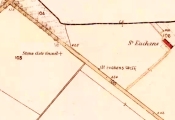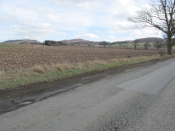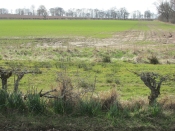Holy Well (destroyed): OS Grid Reference – NO 1997 3297
Also Known as :
- Canmore ID 28605
- St Deuchan’s Well
- St Teuchan’s Well
- St Ukan’s Well
The site of the well is on the north side of the road between Saucher and Collace, just past the small stand of trees.
Archaeology and History
Nothing now remains of the well, but across the road on the strip of grass leading to the burn there is patchy Cotton Grass growth, evidence of the vestigial flow of the spring. A nearby water pumping station on the same side of the road as the former well is probably responsible for the spring well’s demise.
There may have been a nearby chapel dedicated to the Saint, of which no trace remains, and in the 1860s, the Ordnance Survey recorded “A few yards from the site of the chapel there is an excellent spring well by the name of ‘St Teuchan’s Well.’” The Ordnance Survey further recorded “Mr James Stewart, Kinrossie,… supposes [the Saint’s name] to be a corruption from St Vigean’s. Ukans appears to be the common pronunciation, and the T or D of the authorities being silent the spelling Euchans will…answer either of them.”
Saint Euchan was made the titular or patron Saint of Collace by Bishop de Bernham in 1242. The exact identity of the Saint is unclear but he is believed to be the Irish Saint Eoghan, the son of Caennach of Leinster who was ‘carried off in his early youth by pirates to Britain’ later spending some years at Whithorn, before returning to Ireland, where he became the master of St Kevin at Kilnamanach, the monastery he founded in County Wicklow, and Bishop of Ardstraw, County Tyrone. His saint’s day is August 23rd. As there seems to be some doubt as to the Saint’s true identity it is perhaps worth mentioning that Euken is a Basque man’s first name, but this is almost certainly coincidence.
Folklore
The well was at one time believed to have had healing properties.
References:
- Forbes, Alexander Penrose, Kalendars of Scottish Saints, Edmonston and Douglas: Edinburgh 1872.
- Collace Parish Millenium Committee, Off The Main Road, Kinrossie District Recreation Club, 2010
- Scotland’s Place Names
- Gizonezkoen ponte-izenak (Basque Men’s Names) – Euskaltzaindia, Bilbao 2015.
© Paul T Hornby 2016 The Northern Antiquarian
The map could not be loaded. Please contact the site owner.


